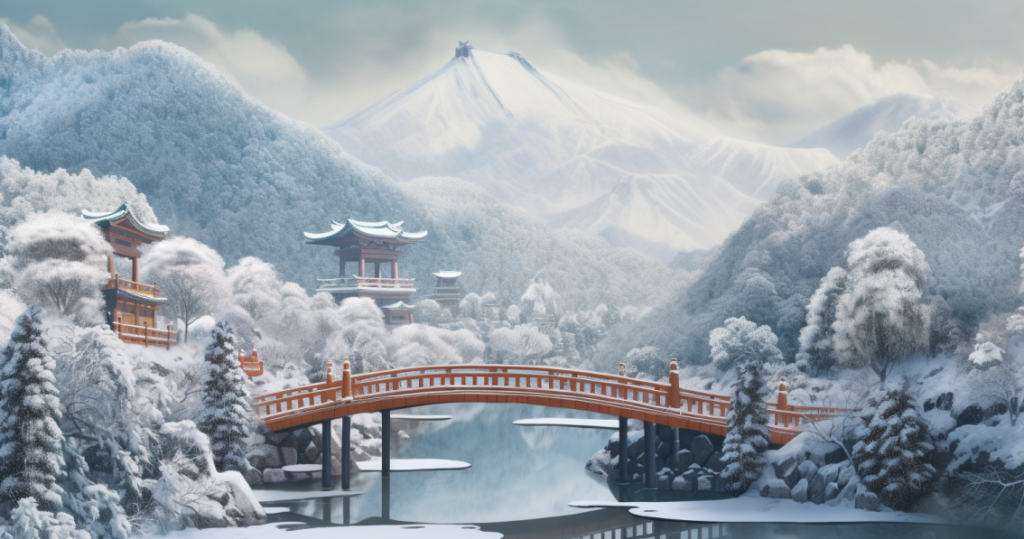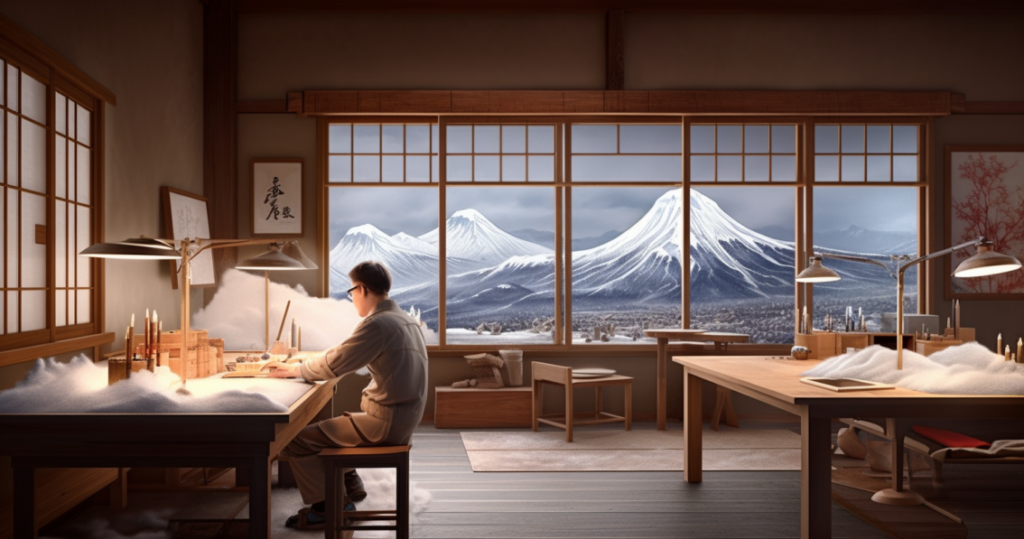When you think of winter painting in Japan, you might wander to serene, snow-covered landscapes and the unique beauty of the season captured through art. The Japanese have a unique way of depicting the cold months, using art forms like Ukiyo-e to show scenes of snow, everyday life, and nature’s quiet moments. Japanese winter art captures the season’s essence, blending natural elements with cultural themes and creating stunning and timeless pieces.
Winter Painting Japan
Exploring winter paintings in Japan gives you a glimpse into how Japanese artists view and represent the coldest season. Each painting tells a story filled with cultural richness and the peacefulness of snow-draped settings. Whether it’s a classic landscape or a glimpse into daily life during winter, these artworks invite you to experience the tranquility and beauty of Japan in the chill of winter.
History of Winter Painting in Japan

Origins and Cultural Significance
Winter paintings in Japan have deep cultural roots. Artists have often portrayed winter to express themes of peace and solitude. The season’s quietness and simplicity reflect aspects of Zen Buddhism, a significant influence on Japanese art.
These paintings often show snowy landscapes, simple yet powerful. Snow is common in these works. It symbolizes purity and beauty. Historical events and folk legends also appear in winter scenes, showing the importance of storytelling in Japanese art. You can see this emphasis on heritage in traditional artworks displayed in museums across Japan.
Famous Winter Scenes in Ukiyo-e
Ukiyo-e artists played a significant role in depicting winter. These woodblock prints, famous from the 17th to 19th centuries, display detailed and colorful scenes. Artists like Hiroshige often focused on Japanese landscapes during snowy seasons, making them relatable and charming.
Hiroshige’s “Snow at Kambara” showcases villagers against a snowy backdrop, reflecting daily life and natural beauty. These prints illustrate artistic skill and how daily life was intertwined with nature.
Inspirational Elements of Japanese Winter Landscapes

Natural Beauty of Snow-Covered Scenery
Imagine walking through a snowy landscape where the world is wrapped in a blanket of white. This purity and stillness have inspired countless Japanese artists. Snow-covered landscapes bring a sense of tranquility and reflection. These scenes capture the quiet elegance of winter, showcasing how snow transforms familiar places into something magical. Artists like Utagawa Hiroshige have masterfully depicted these snowy scenes through ukiyo-e, expressing an almost meditative stillness. The simplicity and beauty of nature in winter provide endless inspiration, inviting viewers to pause and appreciate the gentle details. These paintings often remind you of the fleeting beauty of winter, urging you to capture the moment before it melts away.
Representations of Winter Flora and Fauna
Certain plants and animals become prominent in winter, creating unique scenes in Japanese art. You might see plum blossoms peeking through the snow, representing perseverance and friendship. These blossoms are celebrated in art for their ability to thrive even in cold conditions. Birds like cranes and sparrows often appear in winter art, symbolizing longevity and renewal. Artists capture the delicate balance between life and nature during this stark season. The contrast between dormant trees and lively creatures adds depth to many winter scenes. You might find peace and hope in these representations, as they demonstrate nature’s resilience and beauty, even during winter’s chill.
Influence of Zen Aesthetics
The Zen influence in Japanese winter landscapes is profound, emphasizing simplicity and the essence of nature. Zen aesthetics favor minimalism, focusing on capturing the spirit of winter rather than detailed representations. Think of Sesshū Tōyō’s ink paintings, which use monochrome tones to convey deep emotion and thought. Zen art simplifies complex landscapes into elegant compositions, inviting you to contemplate the essence of winter. Through this lens, the empty spaces in art become just as important as the objects depicted, encouraging mindfulness and reflection. Zen influences bring a spiritual dimension to Japanese winter landscapes, offering inspiration in their serene and meditative qualities.
Frequently Asked Questions – Winter Painting Japan
What are some popular themes for winter painting in Japan?
In Japanese winter paintings, themes often include snow-covered landscapes, delicate flora like bamboo, and famous landmarks blanketed in snow. Artists also capture scenes of people interacting with the cold environment, highlighting the harshness and beauty of winter.
Can you describe the historical background of winter landscapes in Japanese art?
Winter landscapes have been a part of Japanese art for centuries. Influenced by cultural practices and aesthetics, these artworks reflect the beauty and tranquility of winter. Artists like Shoen Uemura have created masterpieces depicting calm and pristine beauty in snowy scenes.
What interpretations and symbolism are often associated with winter in Japanese paintings?
Japanese winter paintings often symbolize purity and tranquility. The snow represents silence and beauty, while the landscapes invoke calmness and reflection. These scenes are rich in symbolism, sometimes signifying the passage of time or the impermanence of life.






